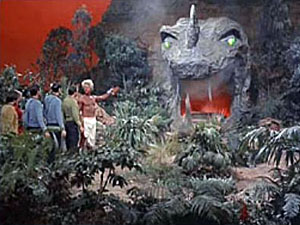 “The Apple” is not one of the more memorable episodes. The title itself brought back no memories at all for me – it wasn’t until I got about 10 minutes in that I recognised what episode this is. Not a good sign.
“The Apple” is not one of the more memorable episodes. The title itself brought back no memories at all for me – it wasn’t until I got about 10 minutes in that I recognised what episode this is. Not a good sign.
Kirk, Spock, McCoy, Chekov, girl of the week Yeoman Martha Landon, and four redshirt security officers beam down to Gamma Trianguli VI, lush with tropical vegetation and a lurid red sky. Chekov compares it to the Garden of Eden, which was just outside Moscow. Chekov has other Eden-esque activities in mind, as we (and Kirk) notice that he and Yeoman Landon are more interested in each other than their duties. Spock says the village they detected from orbit is 17 kilometres away, so they start walking – a very long way to walk, given they have transporter technology that could have placed them right there. This lapse of reason is never explained.
As they set off, redshirt one bites the dust, thanks to being sprayed with poison darts from a lotus-like flower. Following this event, rather than beam back to the Enterprise, or beam down a botanist, or take any sort of precautions whatsoever, Kirk picks up the flower and sniffs it, and then they continue their slog through the jungle to the village. Spock finds a curious rock which he examines, snaps in two, then tosses aside – and it explodes on impact. Another flower takes aim at Kirk, and Spock pushes him aside but takes the full brunt of the darts. McCoy manages to revive Spock, thanks to his Vulcan physiology.
The party realises the Garden of Eden metaphor is strained to breaking point, and Kirk tries to beam everyone up, but it’s too late, as Scotty reports interference from an energy source located near the village. With nothing better to do, they keep walking. Redshirts two and three are annihilated when one is struck by lightning in a sudden storm, and another steps on an explosive rock. Kirk expresses his self-doubts in an emotional speech. Spock interrupts to mention that a native humanoid is lurking nearby.
Kirk intercepts the native and initiates a fistfight, but is taken aback when the native doesn’t fight back, but rather starts weeping and expressing puzzlement at being hit. Kirk reassures the native that he comes in peace. The native says he is Akuta, and is the “Eyes of Vaal”, and leads them to his village, which is populated by about two dozen people, with no children or elders. They are confused by the concepts of children and love. Vaal has forbidden them!
The natives take the crew to Vaal, which turns out to be a symbolically snake-like cave, where the natives leave offerings whenever Vaal calls. Spock decides Vaal is a machine, ruling the naïve villagers like a god. Spock and McCoy engage in a debate about whether Vaal needs to be stopped, and Kirk decides that yes, it does. But Vaal has also decided to get rid of them, telling the natives to attack the crew. Redshirt four goes down in the attack, but the crew best the rest of the villagers (including some well-aimed athletic kicks by Yeoman Landon) and then confine them to a hut. Vaal calls to be fed, but Chekov and Landon are enough to stop the villagers leaving. Kirk calls Scotty to phaser the snake-cave in its weakened state and this destroys it. They then tell the natives that life will be much better now, because they’ll be able to … um … make children now. They warp out of orbit, having interfered with another undeveloped alien civilisation.
Well, this is really a pretty weak and uninspiring episode. The multifarious allusions to the Garden of Eden are possibly the most interesting part. Vaal is a serpent, the villagers are innocent. Kirk even eats an apple conspicuously when they are resting in the village. The denouement even has Spock pointing out that Kirk has effectively played the part of Satan by metaphorically giving the villagers knowledge of good and evil. But ultimately you want some actual drama in the story, and some sensible decision making by the characters, neither of which are particularly in evidence here.
Tropes: Girl Of The Week, World Of Symbolism, In The Original Klingon, Flower In Her Hair, Red Shirt, When Trees Attack, Idiot Plot, Made Of Explodium, Death World, Phlebotinum Breakdown, Bolt Of Divine Retribution, Heroic BSOD, Perfect Pacifist People, I Come In Peace, Uncanny Village, What Is This Thing You Call Love, Cave Mouth, Cargo Cult, Deus Est Machina,
Body count: Redshirts Hendorff (killed by a flower), Kaplan (incinerated by lightning), Mallory (steps on a landmine rock), and Marple (whacked on the head by a native).

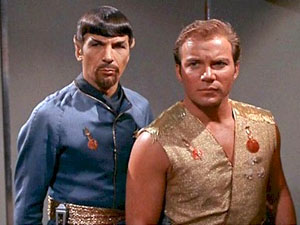 “
“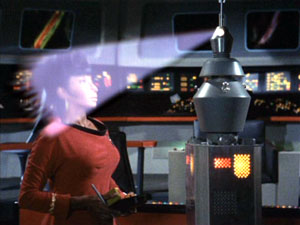 “
“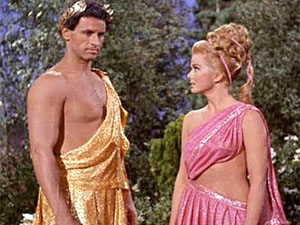 And so to episode 2 of the second season, “
And so to episode 2 of the second season, “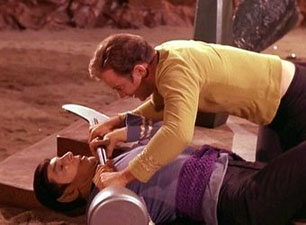 “
“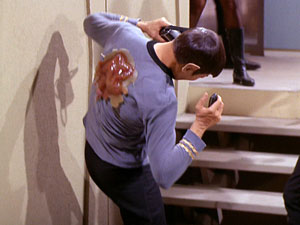 “
“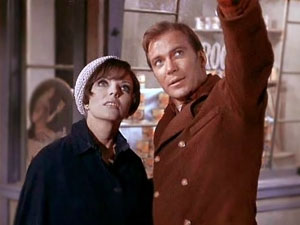 I’ve been waiting for “The City on the Edge of Forever”. If there’s one episode that even non-Star Trek fans should watch, this is the one. It’s often held up as the best episode of the series, and it’s hard to argue otherwise. It won a Hugo award for Best Dramatic Presentation (an honour shared with “
I’ve been waiting for “The City on the Edge of Forever”. If there’s one episode that even non-Star Trek fans should watch, this is the one. It’s often held up as the best episode of the series, and it’s hard to argue otherwise. It won a Hugo award for Best Dramatic Presentation (an honour shared with “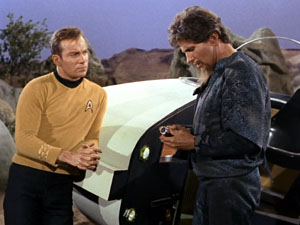 “
“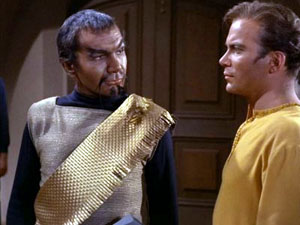 “
“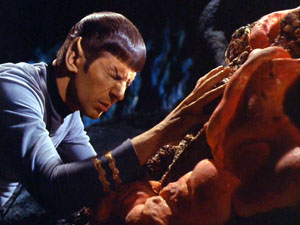 “
“